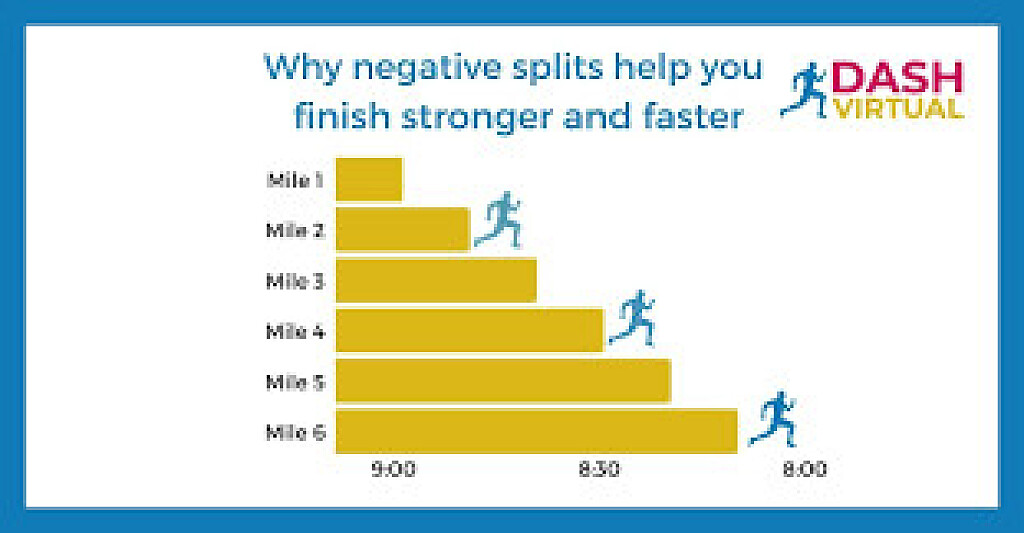Running News Daily
Running News Daily is edited by Bob Anderson. Send your news items to bob@mybestruns.com Advertising opportunities available. Train the Kenyan Way at KATA Kenya and Portugal owned and operated by Bob Anderson. Be sure to catch our movie A Long Run the movie KATA Running Camps and KATA Potato Farms - 31 now open in Kenya! https://kata.ke/
Index to Daily Posts · Sign Up For Updates · Run The World Feed
Here's Why Negative Splits Are the Key to Racing Faster (and Happier)
I wasn't too impressed with my first marathon experience.
Don't get me wrong . . . I loved the 2008 New York City Marathon with its amazing crowd support, challenging course, and the thrill of running through New York's five boroughs.

But like many marathoners, I hit the wall at mile 20. Each subsequent mile was slower than the last, and I felt worse than I ever had in any other race. While I was proud of my finish time, I didn't like how I finished the race.
After more than a decade of coaching marathoners, I've come to a realization that really transformed my relationship to training: how you run a race is just as important as the final result.
If you're able to finish in a way that makes you feel good-if you can finish strong-you're much more likely to consider the race a success and feel more fulfilled by your performance.
One pacing approach of finishing strong is commonly referred to as "negative splitting." Negative splits refer to finishing a race faster than you started. It usually means that the first half is slower than the second, requiring you to speed up during the final half of the race.
This strategy is usually preferred over other race pacing strategies (like positive splits, where you run the first half faster than the last half, or even splits where each half is as close as possible) for a variety of reasons.
First, it's physiologically easier. For races like the half-marathon or longer, it's easier to run faster once the body is fully warmed up. That typically happens only after the first few miles of racing, making a negative split easier to manage.
Second, negative splits leave you feeling more empowered and fulfilled when you finish a race strong. It just feels good! Athletes who negative split races feel more confident after speeding up during the second half of a race.
And finally, it's better for fast times. Most records at the national and world level have been run with negative splits, showing that it's the ideal pacing approach for the fastest times possible. Let's look at some of these performances to inspire our own negative split ambitions.
Negative Splits and Records
A clear trend emerges when you study most world and national records: they were run with negative splits! While not every world record has been run with a negative split, it's the most common approach. Here are a three famous examples:
In 2014, Dennis Kimetto ran the world marathon record in 2:02:57 by running the first half of the race in 61:45 and the second half in 61:12.
Years later, Eliud Kipchoge set another world record in the marathon in 2019 by running 2:01:39. His half-marathon splits were 61:06 and 60:33. He also ran his second half marathon about 10 seconds faster than his first when he broke two hours in the marathon in October 2019 during a time trial.
While most world records at distances over 800m are run with negative splits, this strategy starts to break down at the ultramarathon distances. Many ultra races often have unpredictable terrain, dramatic elevation changes, and higher altitudes. Combined with the sheer distance of ultras, finishing the race slower than you started is usually inevitable. Of course, usually doesn't mean always, though! Arizona ultrarunner Nick Coury, 35, set a 24-hour American Record with an impressive negative split, running 173 miles and clipping off 6-minute miles at the end. It did take this elite athlete more than a decade to refine, but it can be done.
How to Run Negative Splits
Now that we've established the benefits of negative split races, now that we know this approach can be easier and more empowering-not to mention the historic strategizing of negative splits at the highest levels of running-how do we do it ourselves?
If you're able to finish in a way that makes you feel good - if you can finish strong - you're much more likely to consider the race a success and feel more fulfilled by your performance.
Running a race with a negative split is no easy task. It requires much more effort in the second half to run faster because of cumulative fatigue. So how do we train for this feat?
The first step is to get comfortable running negative splits when the stakes are low. Practice finishing an easy distance run faster than you started. It can be helpful to run the first mile at a slower pace to help the warm-up process and the last mile at a more moderate effort. This makes that negative split easier to attain.
You can then practice running a structured workout with negative splits. This is more challenging, since you'll be running at faster efforts and will be pushing yourself in a similar way to a race. (Don't forget your encouraging self-talk.)
This approach works best when you're running a series of repetitions of the same distance (i.e., 6 x 800m) so you can work on each repetition getting slightly faster than the last.
In a race situation, accurate pacing becomes a top priority if the goal is to run negative splits. You must first understand what you're capable of, and what's realistic for you, so you don't start too fast. For example, if you want to negative split your next half marathon and you think you're in shape to run about two hours, it's helpful to run close to this pace for the first 10-11 miles. Running a pace that'll net you a 1:45 finish time is too fast!
Can Negative Splits Make You Happier?
In my coaching opinion, the answer is yes! While the destination (your race result) is important, so is the journey (how you ran the race). Racing negative splits ends the race on a positive note. You finish the race running fast, feeling powerful, and likely outkicking many of your competitors. It's a direct way of imprinting a positive memory on your brain at the very end of a race. That final feeling is lasting and a good reminder of all the effort you put into a race.
For runners who struggle with pre-race anxiety, it can be difficult to frame races as positive experiences that make you feel good. These athletes usually dwell on what can go wrong or how they'll perform. But having just one negative split race is an enormous confidence-booster and can be effective at reducing anxiety in future races.
Even if you don't end up negative splitting a race, we can have an "emotional negative split" by focusing on finishing the race strong. The last mile or half-mile is a great opportunity to pick up the pace, put out those airplane arms, and smile as you charge to the finish line. Positive split or not, you'll finish the race feeling powerful.
If you're a runner who wants to race fast, feel better about your performances, and make racing a more positive experience, try negative splits. They're tough-but so worth it.
by Trail Runner Magazine
Login to leave a comment




